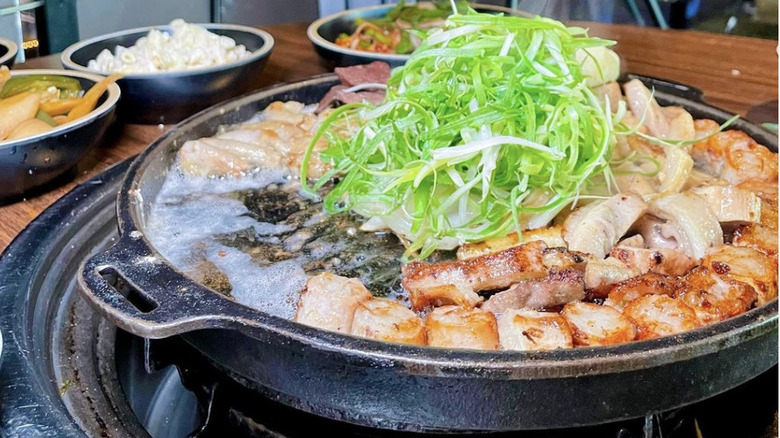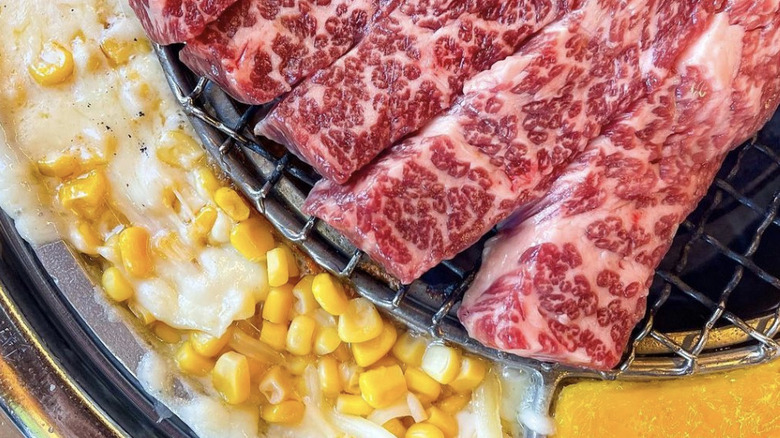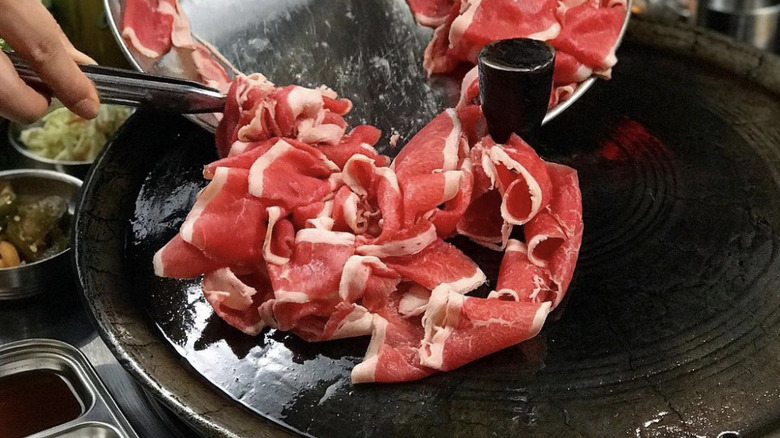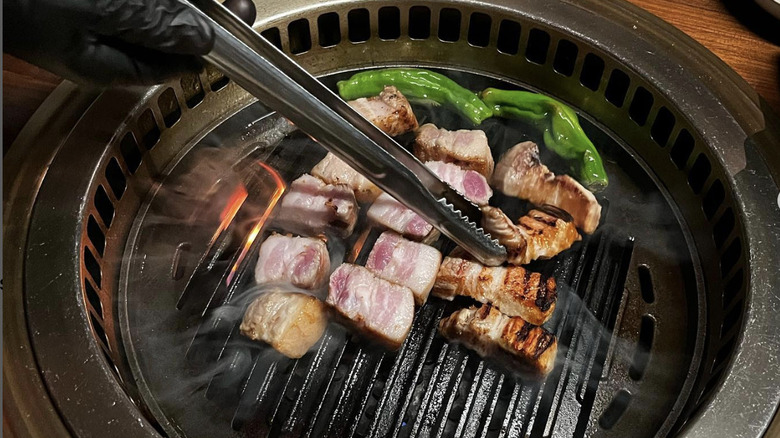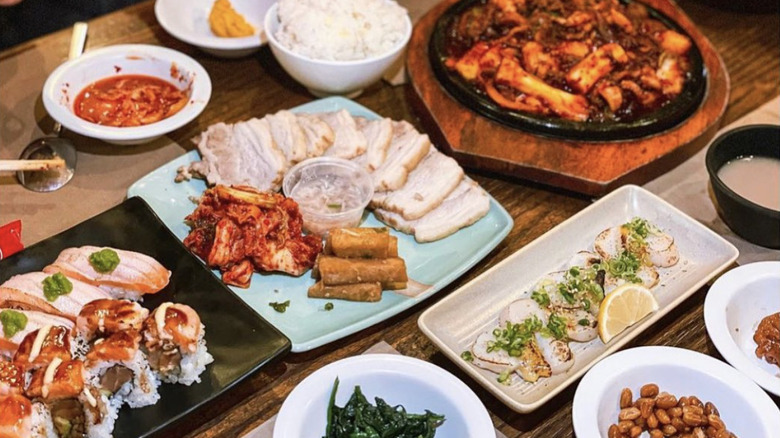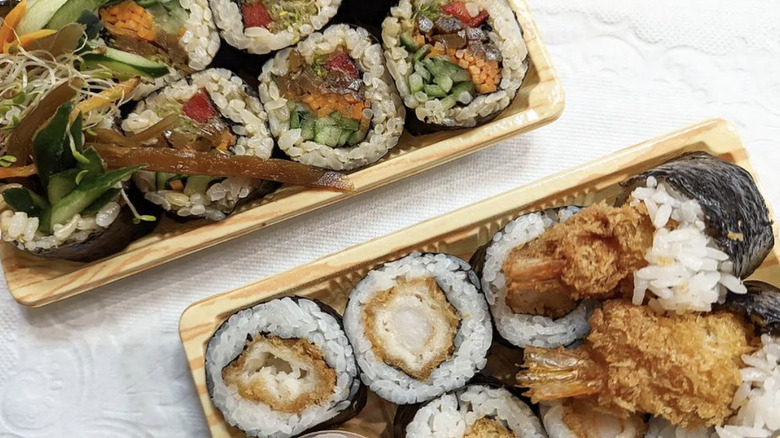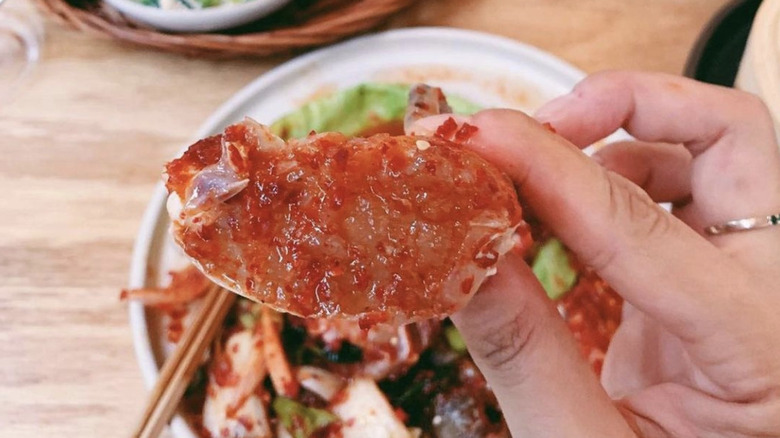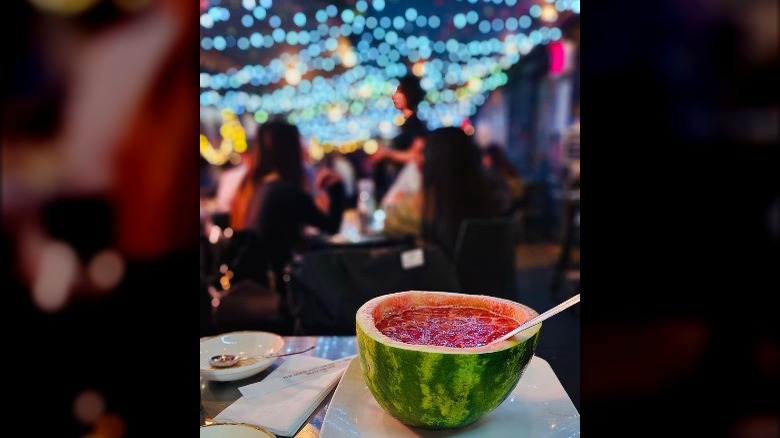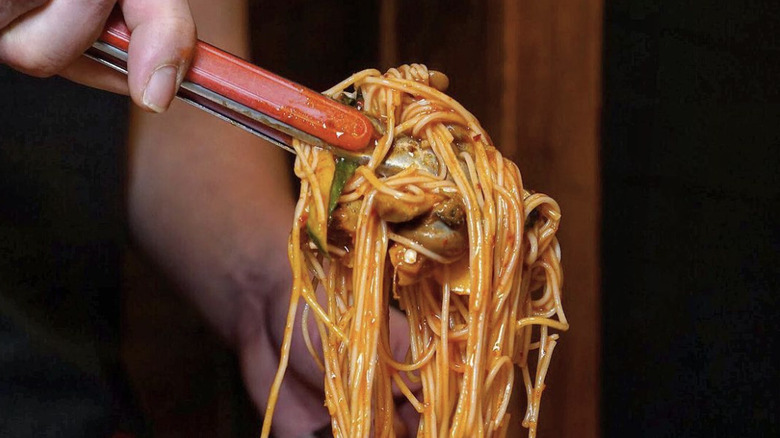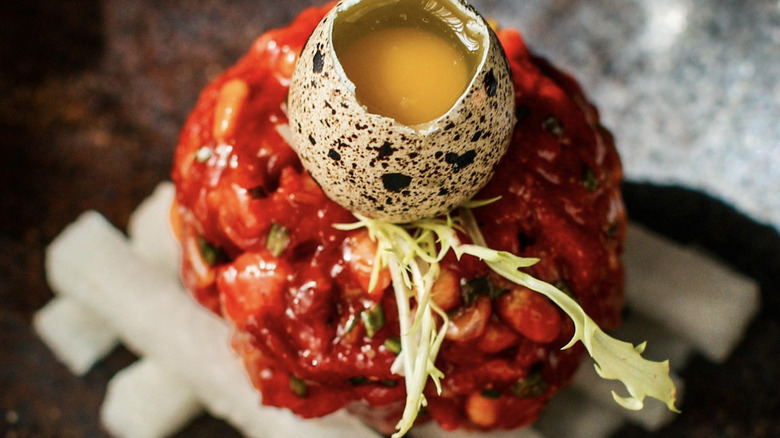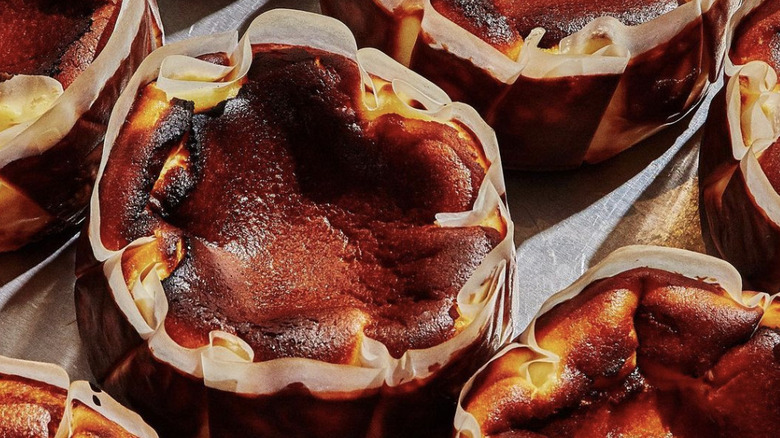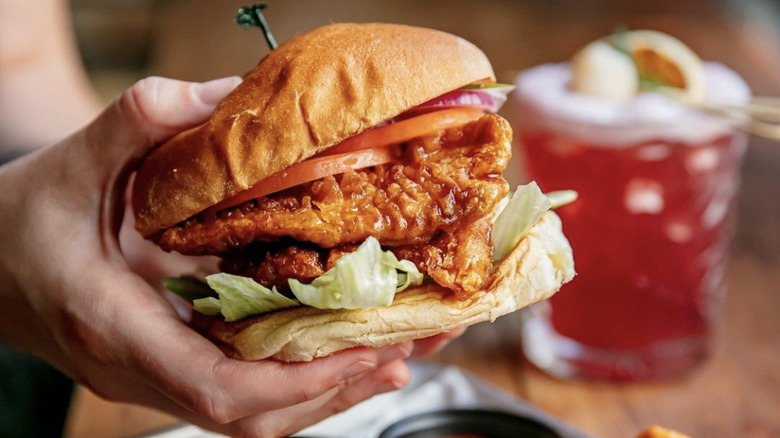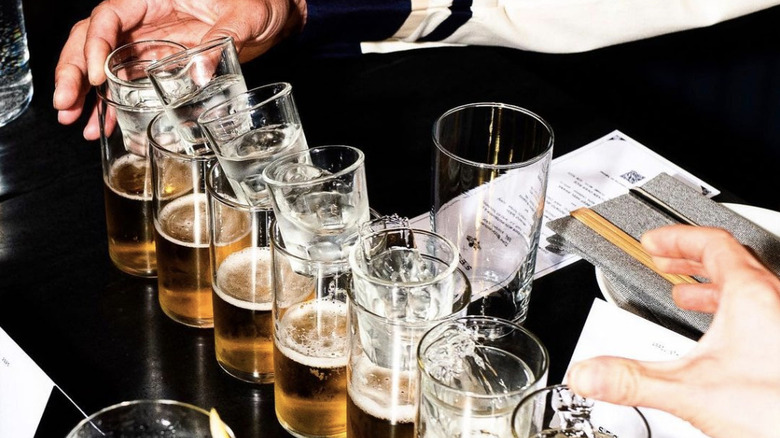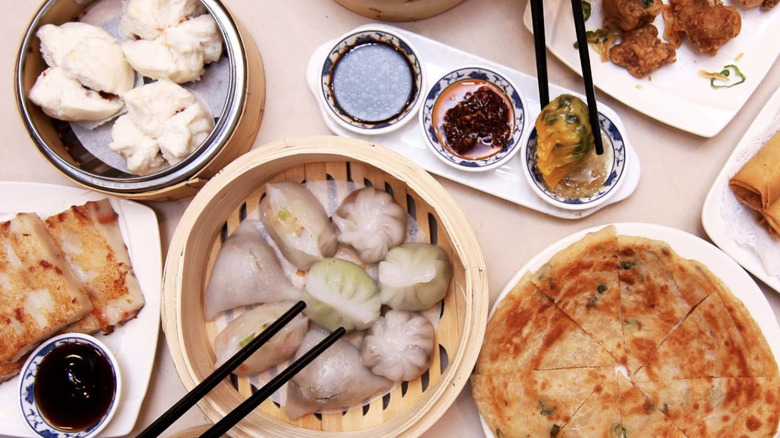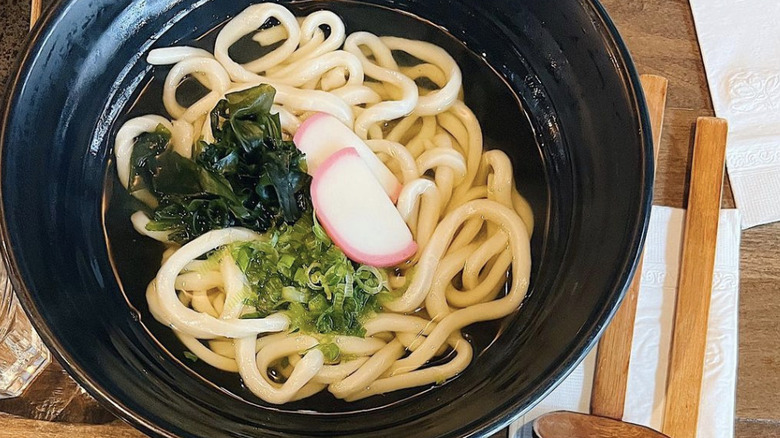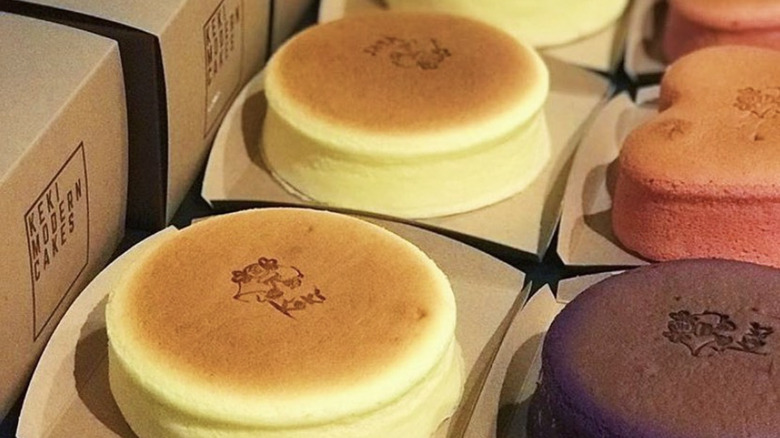16 Best Restaurants In NYC's Koreatown
The first Korean businesses opened on 32nd Street in the 1980s. Back then, it was just a few Korean restaurants and a bookstore crowding into the historic Garment District; soon after, the original businesses' success attracted more Koreans to the area, coinciding with a rising Korean population in the wake of the Immigrant Act of 1965, which lifted restrictions on immigration from Asian countries. Eventually, the stretch of 32nd Street between Madison Avenue and Broadway was so populated with Korean businesses that it earned the official nickname "Korea Way." NYC's K-Town was born.
These days, Koreatown is a tiny neighborhood all its own. It has expanded, stretching from 31st to 33rd between Broadway and Fifth Avenue, with a few restaurants spilling out onto the surrounding blocks. There are more than 100 Korean businesses on Korea Way alone, making it easy to get all the kimbap, bibimbap, budae jjigae, and tteokbokki your heart desires in a matter of a few steps. From traditional Korean cuisine to upscale Korean BBQ joints, bubble tea, cheesecakes, and fun, flirty soju bars, these are the spots you've got to hit if you want to truly experience the diversity of NYC's K-town.
1. Gopchang Story BBQ
First and foremost, we need to talk about Korean barbecue, or KBBQ. The style is always special because the traditional experience entails watching your meat cook in front of you in real time — it's dinner and a show, all in one! So, in a neighborhood almost oversaturated by KBBQ, which places are actually worth visiting?
The first can't-miss spot in Koreatown is Gopchang Story. This restaurant specializes in serving gopchang, which are cow intestines. Although gopchang originally entered Korean cuisine because it was a cheap cut of beef to buy, it's now regarded as a delicacy for its texture and flavor. At Gopchang Story, there's more on the menu than just intestines; you can also get other traditional dishes such as a kimchi joen (pancake) or the fire ddeok-bokki, rice cakes in a spicy, gochujang-flavored stew. Still, the best move is to stick with the classics: order the gopchang, watch those intestines crisp up on the stove right in front of you, and bite in for a chewy burst of fatty flavor.
2. Baekjeong NYC
Often named one of the city's best KBBQs, Baekjeong seemingly only attracts the rich and famous. A mere glimpse at its "hall of fame," displayed prominently both on the website and as you enter the restaurant, shows off stars from Chris Rock to Ed Sheeran — but the real testament to Baekjeong's quality is the number of influential chefs that have been documented visiting the Baekjeong grills, which includes David Chang, Jacques Pépin, Dominique Ansel, and the late, great Anthony Bourdain, among others.
It's hard to get a table at Baekjeong. Once you're in, it's chaotic: the music is loud, and the servers are rushing around in an intricately choreographed dance. This KBBQ haven has the experience down to a science. Before you even sit down, the servers have already arranged upwards of 10 tiny plates of sides at your table, poured eggs into one of the side compartments of the custom grill, layered corn and cheese in another side compartment, and made sure that the grill is clean and hot. At that point, it's up to you to order a meat combo, fast — the cooking has already begun.
3. Let's Meat BBQ
When presented with so many options, it can be hard to pick one KBBQ place over another. Luckily, this one sets itself apart from the rest because it's all-you-can-eat. Each reservation at Let's Meat BBQ lasts 110 minutes, and diners must choose as a table whether to order from the "classic" or "signature" menu. Both of these options end up cheaper than most other KBBQ joints, depending on how much meat you intend on eating. Try your best to eat everything you order, because you can't take anything away from this experience; Let's Meat BBQ doesn't have takeout containers, and charges a hefty per-person fee if there's any meat left at the end of your meal. It's a high-stakes (steaks?) environment.
Let's Meat BBQ also encourages visitors with the motto of "let's drink," and offers a special called the "Somaek Tower," which involves pouring three Sapporos and one bottle of soju into a massive tube at your table. You and your friends can then pour the soju-infused beer into your own cups, and get drunk just as effectively as you're being fed!
4. Nubiani
Nubiani is one of the newest KBBQ places in Koreatown: it opened in the summer of 2022, and has quickly established itself as a respectable place to get some high-quality meat. The word "nubiani" roughly translates to cooking thinly-sliced meat over direct heat, a tradition that has been passed down since early nomadic Koreans in the Goguryeo era began eating maekjeok skewers, and has since transformed into the practice of Korean barbecue.
There are a few appetizers and alternate meals that you can order at Nubiani, but it would be a shame to come here and not sample the KBBQ itself. The meat served here is selected with an eye toward the marbling of fat, and it's absolutely stunning. You can order a selection of beef or pork, but be prepared to pay staggering prices; the best beef package at this place goes for $255, at the time of publication, and contains boneless short ribs, rib eye, skirt steak, and seasoned and marinated short ribs. Wash the meal down with some of Nubiani's house-made refreshing, sour yuzu soft serve.
5. Cho dang gol
KBBQ is by no means the only type of food on offer in New York's K-Town. For more down-to-earth, traditional Korean dishes, head to Cho dang gol, which has been a staple of the neighborhood since 1997. Soft tofu is the thing to order here; all the tofu at Cho dang gol is actually made in-house each day, earning the restaurant the nickname "Tofu House." For this reason, each meal begins with some complimentary tofu.
After sampling that, you might just want to order a fluffy, tofu-based meal by selecting one of the homemade tofu stews as your entree. If not, the dumpling jeongol, a hot pot made with kimchi and assorted seafood and veggies, is also a popular order and worth trying. The care these restauranteurs put into their craft has been rewarded: Cho dang gol has been recognized by the Michelin Guide as a Bib Gourmand restaurant.
6. Woorijip
Woorijip is another spot serving up more traditional Korean fare. It's located in the center of 32nd Street, at the very heart of the neighborhood, and it's an absolute treat. The word "Woorijip" translates to "our home," and it appears that the restaurant aims to provide customers yearning for a return to Seoul a home away from home — and given that it has been in business since the early 2000s, you can tell that the community has accepted this gesture.
Inside, prepackaged meals and sides are stacked in neat rows on racks lining the walls, with a few tables clustered in the front and the back where you can sit and eat your casual Korean home-cooked meal. The best part? There isn't a single dish that costs over $10 in the whole store. In fact, most options are less, at least at the time of publication. Plus, to ease any stressed-out buyers, there are signs hung up next to each stack of containers informing you when the dish was cooked, and when it will be discarded by.
7. Her Name is Han
Her Name is Han aims to offer Korean home-cooked meals just like Woorijip, but in a more upscale setting. This restaurant calls its food "Korean soul food." The menu is slightly more fusion-inspired than some other places on this list; it offers tiramisu and panna cotta alongside more traditional meals like hot pot and bibimbap.
The Yuzu Chicken noodle soup at Her Name is Han is made with knife-cut noodles and house-made broth, aiming to approximate a classic Korean brothy chicken soup called kal-guksu, and is a popular lunchtime order. Meanwhile, the spicy blue crab over white rice is a showstopper. The marinated crab comes raw in its shell and covered in spicy gochujang, and you need to squeeze the crab meat out yourself, which oozes and bubbles on its way out. Unfortunately, this dish is only available seasonally, so make sure you check online before you go.
Finally, if all that spice makes you thirsty, you can also order Her Name is Han's special Sowuju, an infused soju made with fresh fruit, to wash it down.
8. Pocha 32
One Korean specialty that we need to highlighted is soju, an alcohol made from rice or sweet potatoes that is clear-colored, about half as alcoholic as vodka, and usually drunk straight. Food that is meant to be served with soju is called anju, which means you should get ready to both eat and drink heavily at these places.
Pocha 32 is named for the fact that it's located on 32nd Street and offers food-cart-inspired fare. Once you escape the street and head upstairs to its large dining room, you find yourself transported — the dark walls are covered in messages written in colorful marker, and the ceiling is obscured by a net hanging with string lights and the colorful discarded caps of bottles drunk by previous customers. This place has wonderful food — its budae jjigae is a popular nightcap — but it is also notable for its inventive, large cocktails. One of the best things to order here is an extremely Instagram-able cocktail made with soju and served in a hollowed-out watermelon.
9. Bangia
To find Bangia, you need to go down a somewhat-hidden flight of black stairs and pass a sinister golden mannequin. The space itself is dark and industrial, yet warm. It feels like you've stumbled upon a hidden gem, unknown to the bustling crowds outside on 32nd Street.
Don't worry, this speakeasy-slash-eatery isn't as exclusive as it looks. The food is served Bunsik-style, meaning that each dish is like a snack. This spot aims to highlight Korean street foods, and helpfully suggests ordering one of the popular "Bangia Top Five," which include budae jeongol (army soup), marinated pork feet, beef bulgogi, truffle oil chapaguri (noodles) with pork belly, and 10-piece fried chicken wings.
The food is killer, but so are the drinks: Bangia serves brightly-colored shooters and signature cocktails made with imported soju or makgeolli, a sparkling rice wine. There's a killer happy hour here from 5-7 p.m. on Sunday through Thursday. The deals change by day of the week, so make sure you check which one is on ahead of time. On Friday and Saturday nights, this speakeasy is open up until 3 a.m., making it a perfect stop on a bar crawl.
10. Osamil
Osamil is another gastropub serving street-food-style anju and inventive cocktails. Each section of Osamil's menu comes with a slogan: for shareable bites, which include wings and squid fries, the menu states simply, "Fingers were made before forks and hands before knives." Despite the invitation to use your hands, the food here is not casual, and dishes are served with a real eye for presentation.
For example, the beef tartare, or yukhoe, is served in a ball on top of thin sticks of Korean pear arranged in a tic-tac-toe board, with the yolk of a quail egg still in its shell on top. The effect is stunning. Fans also love the Osamil burger, which is made with a half pound of beef and adorned with kimchi bacon jam.
The drinks menu here is run with a sense of humor with drinks named things like "Cold A** Martini" and "Good Drank." The drinks match the energy of the food presentation: Several drinks are served with flowers floating in them, and they have delicate colors and Korean-palate-inspired flavor combos. You can also get half a dozen oysters for $9 only here at happy hour (at the time of publication), which happens from Monday to Thursday, 5-7 p.m.
11. Grace Street Coffee and Desserts
Grace Street Coffee and Desserts is a Korean dessert cafe that isn't located on Grace Street; it's actually on 32nd. This place specializes in outrageous, beautiful desserts. Order at the kiosk in front and then gain entrance to the general dining room, which is reminiscent of a high school cafeteria, if the only thing being served were delicious baked goods.
The Basque burnt cheesecake, one of Grace Street's most popular offerings, comes in two sizes, with either a four-inch or seven-inch diameter. Although Basque cheesecake originally hails from Spain, Grace Street puts a new spin on the recipe by making the center of these cakes gooey and custardy. The four-inch cake is the perfect size to split with a friend.
Grace Street also sells shaved snow in outrageous piles of feathery, creamy layers that are almost a foot tall, with names like "Mango Madness" and "Cookie Monster." If those aren't your speed, you can also opt for bubble tea or a host of matcha-flavored baked goods.
12. Turntable Chicken
Turntable Chicken is a minichain with three locations within the same tiny microneighborhood! Each location has its own vibe. At the Turntable Chicken Jazz location, the decor features hundreds of shelved vinyl records, while the Turntable Chicken Rock location has glossy images of rock and roll greats like the Who and Elvis Presley lining the walls. The Turntable Chicken LP & Karaoke spot hosts vintage stereo equipment. At all three locations, there is a performance space available where DJs can spin actual vinyl — or where you can step up to do some karaoke yourself.
At all the Turntable Chicken locations, you can always order some of the more classic Korean dishes, like spicy rice cakes or kimchi fried rice. The real draw, though, is the Korean fried chicken: You can order wings or thighs with soy garlic sauce or hot and spicy sauce (warning, they're not messing around with the spice!), or a mix of half and half. Huge oysters are also available at a fabulous price.
13. Seoul Salon
Unlike the rest of 33rd Street, with all its flashing lights and neon, the exterior of the new restaurant Seoul Salon is nondescript; it's just a bunch of metal plates and a darkened window, along with a sign that looks like it either says "Seoul Salon" or "Sseaoluoln," depending on how you read it.
This trendy new spot opened on March 28, 2023, and markets itself as a social club. Seoul Salon welcomes diners for a sensory experience: The menus glow with a bright orange light that seems to emanate from nowhere, and visitors are obsessed with the sparkling wall at the end of the hallway that mirrors your motion. The food comes mostly in small plates, with a few larger options like the mala pork belly, the sweet soy sauce braised chicken over glass noodles, and the braised beef heel shank.
Seoul Salon also has a bar area where you can order elaborate signature cocktails. The restaurant also just released its very own soju brand, called "Won Soju," which you can sip as you dine.
14. Dim Sum Palace
Although Koreatown originally only hosted Korean restaurants, it has started to attract businesses and customers from many different Asian cultures. These days, K-Town has become much more diverse than it used to be, with a few really great non-Korean restaurants.
That leads us to the first of our non-Korean offerings, Dim Sum Palace. There are seven Dim Sum Palace locations spread throughout the city, one of which can be found on K-Town's 33rd Street. This Cantonese mini-chain serves Hong Kong-style dim sum all day long.
Inside, pale yellow walls and warm candle-like chandeliers throw a pleasant, elegant light over the meal. Unlike the 200-seat restaurant that the minichain recently opened in Chinatown, the K-Town location serves far fewer customers at a time — but it's also open late at night, closing at 1:30 a.m. on weekend nights. So, the next time you're stumbling home from late-night karaoke, consider stopping for some perfect steamed pork buns on your way.
15. Udon Lab
Udon Lab has become another non-Korean K-Town success because of its Sanuki udon. This noodle style originated in Sanuki, Japan, and is special because the noodles are made with a water content of 40% of the flour weight, making them particularly chewy. Udon Lab opened in early 2020 and it takes its udon seriously enough that there are 19 varieties on the menu, served both cold and hot. To make the perfect noodles, this restaurant allows the udon dough to mature overnight and then processes the noodles with each order that comes into the kitchen, a process which often slows down the kitchen during rush hour.
And Udon Lab does get busy! Even though it's a Japanese restaurant in the middle of Koreatown, Udon Lab does serious business, and it's rare to see the dining room empty. The most popular udon varieties on the menu are the plain udon and the mentaiko cream udon. In addition to the udon, visitors also love the Takoyaki, bite-sized grilled balls that usually contain octopus, ginger, and green onions, and the kaisen don sashimi.
16. Keki Modern Cakes
Our last non-Korean hot spot is Keki, a pan-East Asian bakery that draws its main inspo from Japanese and Taiwanese pastries. The owners are said to be inspired by travels throughout Asia and wanted to bring the pastries they tried on their trips back to NYC. The food scene is better for it.
This shop's most popular offering, the Original Bouncy Cheesecake, is made based on a recipe hailing from Osaka, Japan, and delivers on the promise in its name: the cake is so light and fluffy that if you hit it, it will indeed bounce. Keki also has an Ube-flavored bouncy cheesecake, which has a brilliant purple color, and a series of what it calls "Fancy" cheesecakes, which can feed more people and are sold frozen. Although there's currently no indoor seating at Keki, these modern cakes are great to take home and share with friends and fam.

